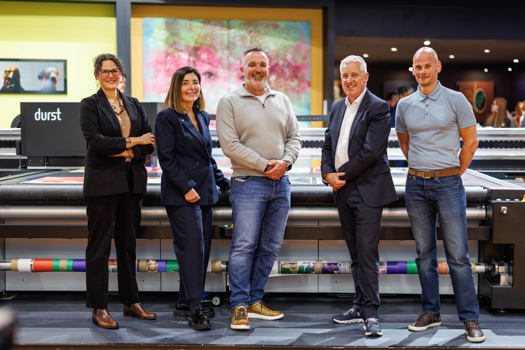According to Mimaki its new device, which is expected to cost around €200,000 (£185,866), is the world’s first 3D printer with more than 10 million colours. It builds objects layer by layer using UV LED curing adding a final UV ink coating of around 22 microns with CMYK, white and clear inks.
It was previewed in its prototype stage at Drupa 2016.
Full-colour modeling enables the device to push the colour gamut, achieving 84% of the Fogra 39L colour gamut and 90% of the Swop gamut, with white ink layers used help create brilliant colour effects.
Another world first for 3D printers, according to the manufacturer, is that the 3DUJ-553 is the first to use colour profiles that not only produce accurate printed colour but also simulation profiles for accurate colour viewing on a monitor.
Mimaki’s new 3D printer, which prints a maximum modelling size of 500x500x300mm, offers high precision droplet laydown with a choice of three dot sizes allowing colour gradations and reduced granularity, according to the manufacturer, while an in-built camera allows users to monitor modelling status.
It can produce five pieces in around 10 hours in standard mode and also offers high definition and high speed modes, while minimal heat application thanks to the LED UV technology and fast start-up time contributes to the device's low power usage and therefore low running costs.
Additionally the acrylic resin contained in the inks produces durability equivalent to ABS resin, which means overcoats can be applied as well as screw attachments and drilling without damaging the objects.
“As the 3D printing market continues to grow, Mimaki has capitalised on an opportunity to bring a truly unique solution to the market,” said Mimaki Europe general manager, Ronald van den Broek.
“Other 3D printing solutions have two primary issues when it comes to creating 3D printed objects. First, they cannot produce objects in photorealistic colour. This often requires that they be hand painted, a time-consuming and expensive prospect. Secondly, most 3D printed objects require removal of stabilising fixtures before they can be used. This again takes time and risks damaging the object,” he explained.
“With the Mimaki 3DUJ-553, both of these barriers are eliminated, since it can print photorealistic colour, choosing from up to 10 million different colours. And its water-soluble support material can easily be washed off without damaging the object. This enables the cost-effective production of exquisite 3D printed products with elaborate finishing,” van den Broek added.
Mimaki expects the 3DUJ-553, which will be available in the UK exclusively through Hybrid Services, to attract particular interest from a range of industries including sign and display graphics, education, healthcare, manufacturing, architecture and construction for colour-realistic production of signs, prototypes, parts and products.
Van den Broek said: “Prospective customers tell us this is exactly the 3D printing solution they have been waiting for, and we expect to see fairly rapid uptake once it is commercially available by the end of this year.”










